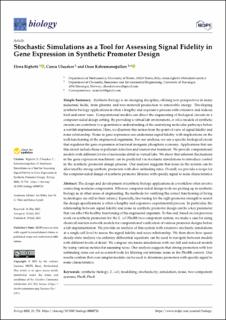| dc.contributor.author | Righetti, Elena | |
| dc.contributor.author | Uluseker, Cansu | |
| dc.contributor.author | Kahramanoğulları, Ozan | |
| dc.date.accessioned | 2021-12-13T15:09:34Z | |
| dc.date.available | 2021-12-13T15:09:34Z | |
| dc.date.created | 2021-12-03T10:07:01Z | |
| dc.date.issued | 2021-07 | |
| dc.identifier.citation | Righetti, E., Uluşeker, C., & Kahramanoğulları, O. (2021). Stochastic Simulations as a Tool for Assessing Signal Fidelity in Gene Expression in Synthetic Promoter Design. Biology, 10(8), 724 | en_US |
| dc.identifier.issn | 2079-7737 | |
| dc.identifier.uri | https://hdl.handle.net/11250/2834044 | |
| dc.description.abstract | The design and development of synthetic biology applications in a workflow often involve connecting modular components. Whereas computer-aided design tools are picking up in synthetic biology as in other areas of engineering, the methods for verifying the correct functioning of living technologies are still in their infancy. Especially, fine-tuning for the right promoter strength to match the design specifications is often a lengthy and expensive experimental process. In particular, the relationship between signal fidelity and noise in synthetic promoter design can be a key parameter that can affect the healthy functioning of the engineered organism. To this end, based on our previous work on synthetic promoters for the E. coli PhoBR two-component system, we make a case for using chemical reaction network models for computational verification of various promoter designs before a lab implementation. We provide an analysis of this system with extensive stochastic simulations at a single-cell level to assess the signal fidelity and noise relationship. We then show how quasi-steady-state analysis via ordinary differential equations can be used to navigate between models with different levels of detail. We compare stochastic simulations with our full and reduced models by using various metrics for assessing noise. Our analysis suggests that strong promoters with low unbinding rates can act as control tools for filtering out intrinsic noise in the PhoBR context. Our results confirm that even simpler models can be used to determine promoters with specific signal to noise characteristics. | en_US |
| dc.language.iso | eng | en_US |
| dc.publisher | MDPI | en_US |
| dc.rights | Navngivelse 4.0 Internasjonal | * |
| dc.rights.uri | http://creativecommons.org/licenses/by/4.0/deed.no | * |
| dc.subject | syntetisk biologi | en_US |
| dc.title | Stochastic simulations as a tool for assessing signal fidelity in gene expression in synthetic promoter design | en_US |
| dc.type | Peer reviewed | en_US |
| dc.type | Journal article | en_US |
| dc.description.version | publishedVersion | en_US |
| dc.rights.holder | © 2021 by the authors | en_US |
| dc.subject.nsi | VDP::Matematikk og Naturvitenskap: 400::Basale biofag: 470 | en_US |
| dc.source.volume | 10 | en_US |
| dc.source.journal | Biology (Basel) | en_US |
| dc.source.issue | 8 | en_US |
| dc.identifier.doi | 10.3390/biology10080724 | |
| dc.identifier.cristin | 1964017 | |
| dc.source.articlenumber | 724 | en_US |
| cristin.ispublished | true | |
| cristin.fulltext | original | |
| cristin.qualitycode | 1 | |

